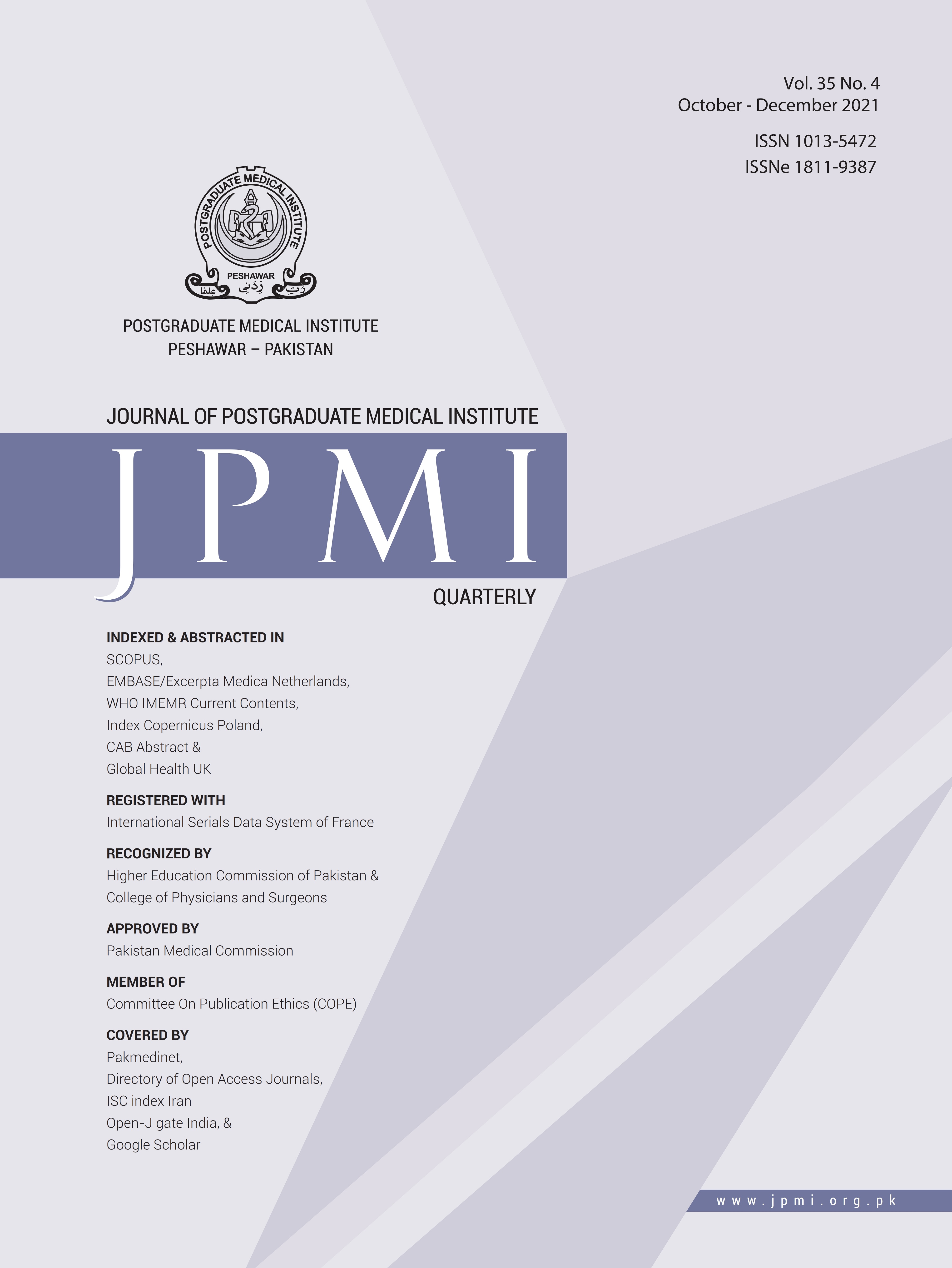BULLYING, VICTIMIZATION, AND REJECTION SENSITIVITY IN ADOLESCENTS: MEDIATING ROLE OF SELF-REGULATION
Main Article Content
Abstract
Objective: To explore the mediating role of self-regulation in bullying, victimization as related with rejection sensitivity among adolescents.
Methodology: This cross-sectional research was conducted at the Department of Psychology, University of Gujrat after taking approval from Advanced Studies and Research Board. In first phase, Self-Regulation Questionnaire (SRQ) and Rejection Sensitivity Questionnaire (RSQ) were translated into Urdu language by forward-backward translation method after taking permission from their respective authors. For pilot-testing, these scales were administered on 130 students and scales were found to be reliable with a=0.83 and a=0.85 respectively. In second phase, Urdu version of Adolescent Peer Relations Instrument (ARRI) by Parada, SRQ, and RSQ were administered to a sample of 608 college students. Stratified Random Sampling technique was use to collect the data. The data was analyzed in AMOS-21.
Results: The study reported male as 330, and female as 278, age range between 16 to 19 years with mean of 17.60±0.83 years. The model fit indices of chi-square/df =2.2 (p<0.001), Goodness of fit (GFI)=0.94, Adjusted goodness of fit (AGFI)=0.91, Comparative fit index (CFI)=0.904, Incremental fit index (IFI)=0.906, Tucker Lewis index (TLI)= 0.88 and Root Mean Square Error of Approximation (RMSEA)=0.046 were in the acceptable limits. Structure Equation Model in AMOS-21 showed significant mediating role of self-regulation with bullying, victimization and rejection sensitivity among adolescents.
Conclusion: Self-regulation has fully and significantly mediated the association of both bullying and victimization with the level of sensitivity for rejection in adolescents.
Article Details
Work published in JPMI is licensed under a
Creative Commons Attribution-NonCommercial 2.0 Generic License.
Authors are permitted and encouraged to post their work online (e.g., in institutional repositories or on their website) prior to and during the submission process, as it can lead to productive exchanges, as well as earlier and greater citation of published work.
References
Shahzadi N, Akram B, Dawood S, Bibi B. Bullying Behavior in Rural Area Schools of Gujrat, Pakistan: Prevalence and Gender Differences. Pak J Soc Clinc Psychol. 2019; 17(1): 25-30.
Posner MI, Rothbart MK. Developing mechanisms of self-regulation. Dev Psychopathol. 2000; 12(3): 427-41.
Nansel TR, Overpeck MD, Haynie DL, Ruan WJ, Scheidt PC. Relationships be¬tween bullying and violence among US youth. Arch Pediatr Adolesc Med. 2003; 157(4): 348-53.
Terada M, Kawamoto T. Rejection sen¬sitivity, self-efficacy, and learning strat¬egy: Mediating and moderating the role of basic needs satisfaction. Psychol. 2017; 8(03):449-462. Doi: 10.4236/ psych.2017.83028
Downey G, Feldman SI. Implications of rejection sensitivity for intimate relation¬ships. J Pers Soc Psychol. 1996; 70(6): 1327.-31.
Rose AJ, Rudolph KD. A review of sex differences in peer relationship pro¬cesses: potential trade-offs for the emotional and behavioral development of girls and boys. Psychol Bull. 2006; 132(1): 98-131.
Prinstein MJ, Brechwald WA, Cohen GL. Susceptibility to peer influence: Using a performance-based measure to identify adolescent males at heightened risk for deviant peer socialization. Dev Psychol. 2011; 47(4): 1167-72.
Haltigan JD, Vaillancourt T. Joint trajec¬tories of bullying and peer victimization across elementary and middle school and associations with symptoms of psychopathology. Dev Psychol. 2014; 50(11): 2426-36.
McCoy SS, Dimler LM, Samuels DV, Natsuaki MN. Adolescent susceptibility to deviant peer pressure: Does gender matter? Adolesc Res Rev. 2019; 4(1): 59-71.
Mischel W, Shoda Y. A cognitive-affec¬tive system theory of personality: con¬ceptualizing situations, dispositions, dynamics, and invariance in personality structure. Psychol Rev. 1995; 102(2): 246-268.
Ayduk Ö, Gyurak A. Applying the cog¬nitive-affective processing systems ap¬proach to conceptualizing rejection sen¬sitivity. Soc Personal Psychol Compass. 2008; 2(5): 2016-2033.
Gaumer EAS, Noonan PM. Self-regula¬tion assessment suite: Technical report. College & Career Competency Frame¬work. 2020.
Downey G, Feldman SI. RSQ/RS-Per¬sonal. J Pers Soc Psychol. 2013; 70:1327-43.
Shafiq S, Batool S. Bullying, Victimiza¬tion, Rejection Sensitivity, and Self-Reg¬ulation in Positive Development of Ado¬lescents. J Liaquat Uni Med Health Sci. In press 2022.
Finger L, Yeung AS, Craven R, Parada R, Newey K. Adolescent peer relations instrument: Assessment of its reliability and construct validity when used with upper primary students. In Australian Association for Research in Education Annual Conference. 2008.
16. Naveed S, Waqas A, Shah Z, Ahmad W, Wasim M, Rasheed J, Afzaal T. Trends in bullying and emotional and behavioral difficulties among Pakistani school¬children: a cross-sectional survey of seven cities. Front Psychiatry. 2020; 17(10):976.
17. Bibi A, Blackwell SE, Margraf J. Mental health, suicidal ideation and experience of bullying among university students in Pakistan. J Health Psychol. 2019; 23:135.
18. Yamane T. Statistics: An Introductory Analysis, 2nd Edition. New York: Harper and Row.1967.
19. Bailen NH, Green LM, Thompson RJ. (2019). Understanding emotion in ad¬olescents: A review of emotional fre¬quency, intensity, instability and clari¬ty. Emotion Rev. 2019; 11(1):63-73.
20. Garner PW, Hinton TS. Emotional display rules and emotion self-regulation: Asso¬ciations with bullying and victimization in community-based after school pro¬grams. J Community Appl Soc Psychol. 2010; 20(6):480-96.
21. Ayduk O, Mendoza-Denton R, Mischel W, Downey G, Peake PK, Rodriguez M. Regulating the interpersonal self: stra¬tegic self-regulation for coping with re¬jection sensitivity. J Pers Soc Psychol. 2000; 79(5): 776. –792. https://doi. org/10.1037/0022-3514.79.5.776.
22. Zimmer-Gembeck MJ. Peer rejection, victimization and relational self-system processes in adolescence: Toward a transactional model of stress, coping, and developing sensitivities. Child Dev Perspect. 2016; 10(2): 122-7.
23. Naseem T. Step parents’ rejection, peer rejection sensitivity and bullying-victim¬ization among children [dissertation]. Univ Management Technology; 2017.
24. Yu L, Chan KL. Moderating effects of personal strengths in the relationship between juvenile victimization and de¬linquent behaviors. Child Abuse Negl. 2019; 93: 79-90.
25. Rudolph KD, Troop-Gordon W, Flynn M. Relational victimization predicts chil¬dren’s social-cognitive and self-reg¬ulatory responses in a challenging peer context. Dev Psychol. 2009; 45(5):1444. –1454. doi.org/10.1037/ a0014858
26. Adrian M, Jenness JL, Kuehn KS, Smith MR, McLaughlin KA. Emotion regulation processes linking peer victimization to anxiety and depression symptoms in adolescence. Dev Psychopathol. 2019; 31(3):999-1009. Doi: 10.1017/ S0954579419000543.
27. Aslam R, Khan N, Joseph V. Impact of Learning Motivation on Students’ Aca¬demic Achievement: Mediating Role of Constructive Feedback. Pak Soc Sci Rev. 2021; 5(3): 472-484. Doi: 10.35484/ pssr.2021(5-III)35.


